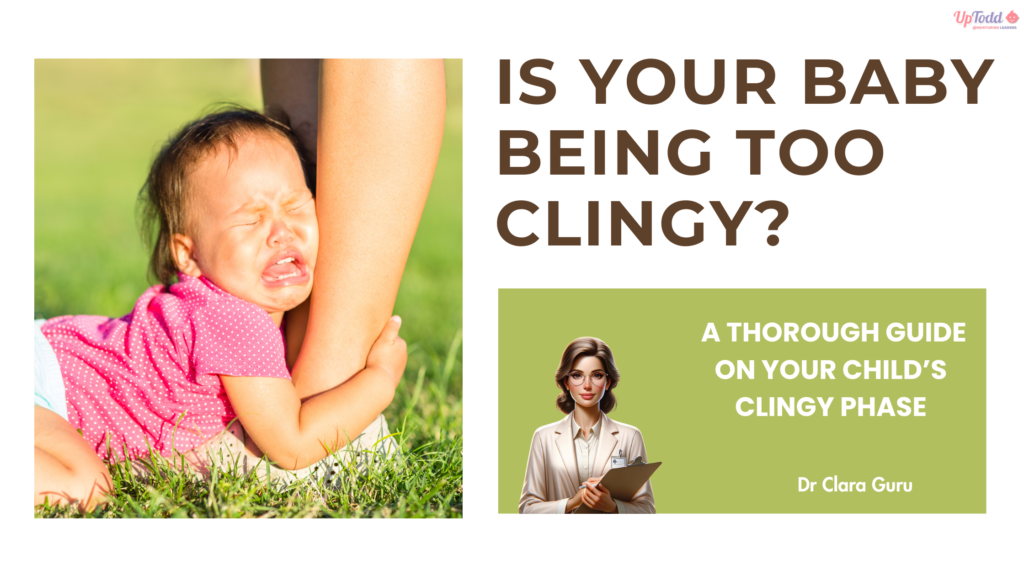
Seeing your baby cry when you step out of the room? You’re navigating the clingy baby phase. This period, marked by what experts like Dr. Clara Guru call separation anxiety, is a normal part of your baby’s growth. Let’s dive into what makes your baby clingy and how to ease their stress.
Why Babies Become Clingy
Clinginess is a signal your baby misses you. It’s most intense around 9 to 18 months but can start as early as 4 months. What’s happening?
Key Insights:
-
- Early Signs: Clinginess can show as soon as 4-5 months.
-
- Intense Phase: Around 9 months, clinginess hits a peak.
-
- Individual Experience: Each baby reacts differently.
Reference from How to approach separation anxiety in babies
Recognizing Clinginess in Babies
Clinginess comes in many forms. Common signs include:
-
- Crying when you leave. Even a short absence triggers tears.
- Clinging tightly. Your baby doesn’t want you to go.
- Distress around strangers. Familiar faces are their comfort zone.
Reference from How to approach separation anxiety in babies
Causes Behind Clinginess
7-9 Months: Babies develop object permanence. They know you exist, even when unseen, making separations harder.
9-18 Months: Recognition skills improve. They understand who’s who, and not seeing their primary caregiver, usually the parent, can cause distress.
How to Alleviate Clinginess
Here’s how you can support your baby during this phase:
Strategies for Home Comfort:
-
- Start with Short Separations: Increase the distance gradually.
-
- Maintain a Positive Attitude: Your confidence reassures your baby.
-
- Offer a Comfort Object: A familiar toy can be a great comfort.
Tips for When You Must Leave:
-
- Introduce the Concept Gradually: Begin with quick separations.
- Communicate About Your Return: Always explain that you’ll come back.
- Simplify Goodbyes: Quick and cheerful farewells are less stressful.
The Brain’s Role
Understanding your baby’s brain helps. The amygdala, which processes emotions, is highly active during these times, causing the fear response when you’re not around. The prefrontal cortex, which helps regulate emotions, isn’t fully developed yet, making it harder for your baby to manage their feelings.
A Period of Growth and Attachment
This clingy phase, though challenging, is a significant milestone. It signifies your child’s growing attachment and their emotional development. By adopting gentle, reassuring strategies, you can help your baby navigate this phase more smoothly. Remember, patience and consistency are key. This stage is temporary, and navigating it thoughtfully strengthens the bond between you and your child.
Reference from How to approach separation anxiety in babies
Final Thoughts BY Dr Clara Guru
Dealing with a clingy baby can be taxing, but understanding the why behind the behaviour and how to address it can make a big difference. Implementing these strategies not only helps your baby feel more secure but also promotes healthy emotional development. As you and your baby grow through this phase together, remember that each day brings new opportunities for bonding and learning.
Frequently Asked Questions About Clingy Baby and Separation Anxiety
Why is my baby suddenly so clingy?
Your baby becomes clingy when they start to understand that people, including you, exist even when out of sight. This realization often happens around 4 to 18 months and is a sign of healthy emotional development. It means your baby loves and trusts you enough to miss you when you’re gone.
How long does the clingy baby phase last?
The clingy phase can start as early as 4 months and might last until they’re around 3 years old. However, its intensity varies. Most babies show peak clinginess between 9 to 18 months. As they grow and gain independence, their need for constant physical closeness decreases.
Can I prevent my baby from becoming clingy?
It’s not about preventing clinginess but managing it with understanding and care. Clinginess is a normal stage of development. Offering comfort, practicing short separations, and maintaining routines can help your baby become more comfortable with independence over time.
What are the signs of separation anxiety in babies?
Signs include crying when a caregiver leaves, reluctance to be with strangers, and physical clinginess. Babies might also show changes in sleeping patterns, such as waking up crying for you in the night. These behaviors indicate your baby’s growing understanding of the world and attachment to you.
How can I soothe my clingy baby?
Soothing a clingy baby involves patience, presence, and reassurance. Try to:
-
- Keep goodbyes short but sweet, ensuring you always say goodbye.
-
- Leave a comforting item like a worn shirt.
-
- Practice being apart for short durations.
-
- Keep your promises about returning.
Does clinginess mean my baby has an attachment issue?
Not necessarily. Most of the time, clinginess is a normal stage of emotional development. It shows your baby has formed a strong attachment to you. However, if you’re concerned about your baby’s clinginess or it seems excessive, consulting a child development expert can provide peace of mind.
How does clinginess affect my baby’s brain development?
Clinginess and separation anxiety are linked to the amygdala and prefrontal cortex in the brain, areas responsible for processing emotions. These feelings are a part of your baby’s natural emotional growth. Handling this phase sensitively can support healthy brain development, ensuring your baby feels secure and loved.
Explore UpTodd Personalised Program to unlock hidden abilities
